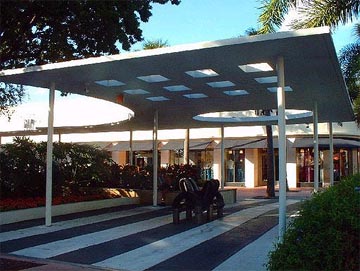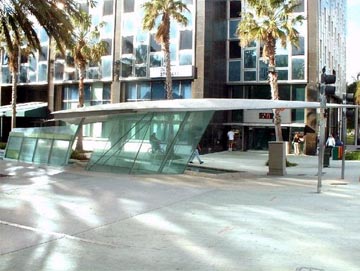Touching on an idea that demands more examination, should we start to think about public art as vernacular? Do we commission so much public art that cultural integration should be prioritized in the same manner of vernacular architecture?

As a starting point, check out Lincoln Road, a pedestrians-only roadway in Miami Beach. Lincoln Road is packed with cafes, tables, awnings, signs, lights and people. When the road was closed in 1960, the great master of Miami Beach architecture – Morris Lapidus – designed a series of artistic follies. Each shade structures exploits one 20th century technology in concrete construction – folded plates, cantilevers, floating slabs, etc. 47 years later, the follies have a quiet energy and clarity of form that hold their place among the chaos.
In 1999, the Miami young turks, Carlos Zapata with Benjamin Wood, designed a new folly in the style of “deconstruction”. Unlike the Lapidus, the form strains to be unique, or to be art. A vast curving, falling, knife-life roof juts from an impossible support of green glass. Unlike the Lapidus, no one touches the Zapata – Wood sculpture.

In the Lapidus Lincoln Road Visual Essay, the photos show the strength of the Lapidus among the activity. The follies stand with alone with dignity or as backdrops for fashion, drinking and even other artworks.
I think public art can take a lesson from architecture that the public art belongs to the place and starts to be used. Really used. Som public art might become vernacular – loved by the trained eye and just part of everything to the uninterested.
Public Art, Public Space

I think you are making some revisionist jumps in thinking there when you infer that Lapidus was not trying to be unique, or that he, or others at the time, did not consider his works on Lincoln Rd. to be “art”. Maybe he wasnt “straining”, but that was just because he was so good at what he did.
I have always loved his title for his autobiography- “too much is never enough”- he certainly was aware of what he was doing, and I am sure he had his own opinions on whether or not it was “art”.
Public sculptures, or follies, achieve a familiar, comfortable and loved status based on their own characteristics, and how well they were done in the first place, and how well they fit in.
Lapidus was a pro, as well as an artist, and it shows.
I wonder though, about your definition (unstated) of vernacular- generally, this to me would suggest a piece that is NOT designed, but built in a prevailing, comfortable local style, something more subconcious in the minds of local craftsmen, as opposed to a sculpture or piece of architecture like these Lapidus pieces, that is VERY considered.
For instance, a forged iron cross on a scandanavian grave in the upper midwest would be “vernacular”- an individual craftsman, working within an established style.
Or a bungalow in Jamaica, built by masons without plans or architect.
But Lapidus- I dont see that as vernacular. He helped write the design vocabulary of South Florida, and some of his ideas may have been absorbed into a common vernacular of “deco” strip malls, but his own work wasnt vernacular.
And public sculpture, by its very nature, can become comfortable, or part of the familiar landscape, but it is almost never vernacular in the sense I would use the word.